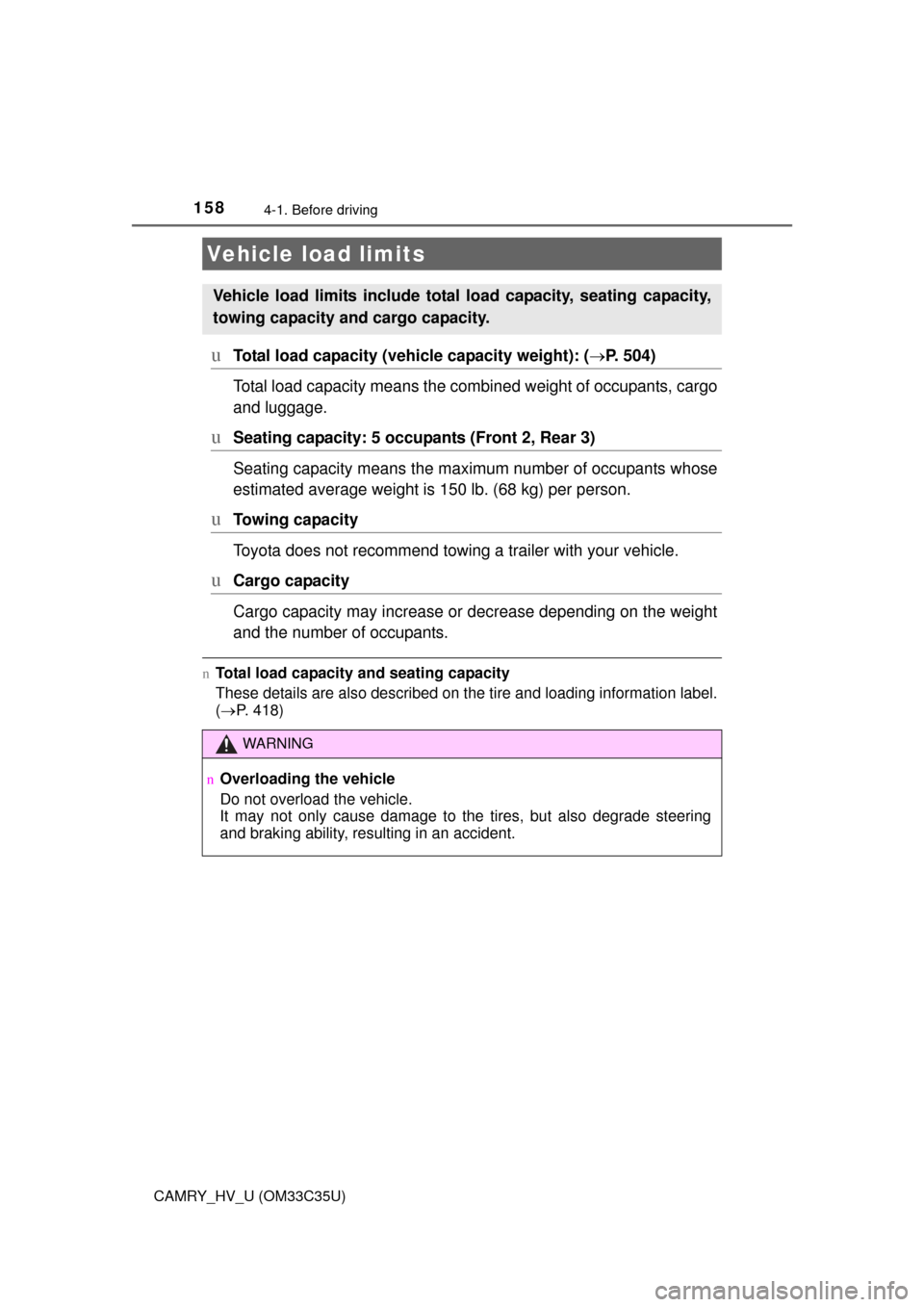2016 TOYOTA CAMRY HYBRID tires
[x] Cancel search: tiresPage 6 of 572

TABLE OF CONTENTS6
CAMRY_HV_U (OM33C35U)7-1. Maintenance and care
Cleaning and protecting the vehicle exterior .......... 378
Cleaning and protecting the vehicle interior ........... 381
7-2. Maintenance Maintenance requirements ................... 384
General maintenance ........ 387
Emission inspection and maintenance (I/M)
programs ......................... 391
7-3. Do-it-yourself maintenance
Do-it-yourself service precautions ..................... 392
Hood.................................. 394
Positioning a floor jack ...... 395
Engine compartment ......... 396
12-volt battery ................... 404
Tires .................................. 408
Tire inflation pressure........ 418
Wheels .............................. 421
Air conditioning filter .......... 423
Electronic key battery ........ 425
Checking and replacing fuses ............................... 427
Light bulbs ......................... 430 8-1. Essential information
Emergency flashers ........... 440
If your vehicle has to be stopped in an
emergency....................... 441
8-2. Steps to take in an emergency
If your vehicle needs to be towed .......................... 442
If you think something is wrong............................... 445
If a warning light turns on or a warning buzzer
sounds ............................. 446
If a warning message or indicator is
displayed ......................... 455
If you have a flat tire .......... 473
If the hybrid system will not start ........................... 484
If the shift lever cannot be shifted from P ............. 486
If the electronic key does not operate
properly ........................... 487
If the vehicle 12-volt battery is discharged ....... 490
If your vehicle overheats.... 496
If the vehicle becomes stuck ................................ 500
7Maintenance and care8When trouble arises
Page 17 of 572

17Pictorial index
CAMRY_HV_U (OM33C35U)Windshield wipers . . . . . . . . . . . . . . . . . . . . . . . . . . . . . . . . . P. 180
Precautions against winter season . . . . . . . . . . . . . . . . . . . . . P. 242
Fuel filler door . . . . . . . . . . . . . . . . . . . . . . . . . . . . . . . . . . . . P. 182
Refueling method. . . . . . . . . . . . . . . . . . . . . . . . . . . . . . . . . . . P. 182
Fuel type/fuel tank capacity . . . . . . . . . . . . . . . . . . . . . . . . . . . P. 506
Tires . . . . . . . . . . . . . . . . . . . . . . . . . . . . . . . . . . . . . . . . . . P. 408
Tire size/inflation pressure . . . . . . . . . . . . . . . . . . . . . . . . . P. 511
Winter tires/tire chains . . . . . . . . . . . . . . . . . . . . . . . . . . . . P. 242
Checking/rotation/tire pressure warning system
*. . . . . . . . P. 408
Coping with flat tires . . . . . . . . . . . . . . . . . . . . . . . . . . . . . . P. 473
Hood . . . . . . . . . . . . . . . . . . . . . . . . . . . . . . . . . . . . . . . . . . . . P. 394
Opening . . . . . . . . . . . . . . . . . . . . . . . . . . . . . . . . . . . . . . . . . . P. 394
Engine oil . . . . . . . . . . . . . . . . . . . . . . . . . . . . . . . . . . . . . . . . . P. 507
Coping with overheat . . . . . . . . . . . . . . . . . . . . . . . . . . . . . . . . P. 496
Warning message . . . . . . . . . . . . . . . . . . . . . . . . . . . . . . . . . . P. 456
Headlights/halogen daytime running lights
* . . . . . . . . . . . P. 172
Front turn signal/parking lights/
LED daytime running lights
* . . . . . . . . . . . . . . . . . . . . . . . . P. 172
Front side marker lights . . . . . . . . . . . . . . . . . . . . . . . . . . . . P. 172
Rear turn signal lights . . . . . . . . . . . . . . . . . . . . . . . . . . . . . . P. 170
Stop/tail lights/rear side marker lights . . . . . . . . . . . . . . . . . P. 172
Back-up lights
Shifting the shift lever to R . . . . . . . . . . . . . . . . . . . . . . . . . . . . P. 168
License plate lights . . . . . . . . . . . . . . . . . . . . . . . . . . . . . . . . P. 172
4
5
6
7
Light bulbs of the exterior lights for driving
(Replacing method: P. 430, Watts: P. 512)
*: If equipped
8
9
10
11
12
13
14
Page 149 of 572

1494-1. Before driving
4
Driving
CAMRY_HV_U (OM33C35U)
nWhen starting off on an uphill
The hill-start assist control will activate. ( P. 218)
n For fuel-efficient driving
Keep in mind that hybrid vehicles are similar to conventional vehicles, and it
is necessary to refrain from activities such as sudden acceleration. ( P. 239)
n Driving in the rain
lDrive carefully when it is raining, because visibility will be reduced, the win-
dows may become fogged-up, and the road will be slippery.
l Drive carefully when it starts to rain, because the road surface will be espe-
cially slippery.
l Refrain from high speeds when driving on an expressway in the rain,
because there may be a layer of water between the tires and the road sur-
face, preventing the steering and brakes from operating properly.
n Breaking in your new Toyota
To extend the life of the vehicle, observing the following precautions is recom-
mended:
lFor the first 186 miles (300 km):
Avoid sudden stops.
l For the first 621 miles (1000 km):
• Do not drive at extremely high speeds.
• Avoid sudden acceleration.
• Do not drive continuously in low gears.
• Do not drive at a constant speed for extended periods.
n Drum-in-disc type parking brake system
Your vehicle has a drum-in-disc type parking brake system. This type of brake
system needs bedding-down of the brake shoes periodically or whenever the
parking brake shoes and/or drum are replaced. Have your Toyota dealer per-
form the bedding down operation.
n Operating your vehicle in a foreign country
Comply with the relevant vehicle registration laws and confirm the availability
of the correct fuel. ( P. 506)
Page 151 of 572

1514-1. Before driving
4
Driving
CAMRY_HV_U (OM33C35U)
WARNING
Observe the following precautions.
Failure to do so may result in death or serious injury.
nWhen driving the vehicle
lDo not drive in excess of the speed limit. Even if the legal speed limit per-
mits it, do not drive over 85 mph ( 140 km/h) unless your vehicle has high-
speed capability tires. Driving over 85 mph (140 km/h) may result in tire
failure, loss of control and possible injury. Be sure to consult a tire dealer
to determine whether the tires on y our vehicle are high-speed capability
tires or not before driving at such speeds.
n When driving on slippery road surfaces
lSudden braking, acceleration and steering may cause tire slippage and
reduce your ability to control the vehicle.
l Sudden acceleration, engine braking due to shifting, or changes in engine
speed could cause the vehicle to skid.
l After driving through a puddle, lightly depress the brake pedal to make
sure that the brakes are functioning properly. Wet brake pads may prevent
the brakes from functioning properly. If the brakes on only one side are wet
and not functioning properly, steering control may be affected.
n When shifting the shift lever
lDo not let the vehicle roll backward while the shift lever is in a driving posi-
tion, or roll forward while the shift lever is in R.
Doing so may result in an accident or damage to the vehicle.
l Do not shift the shift lever to P while the vehicle is moving.
Doing so can damage the transmission and may result in a loss of vehicle
control.
l Do not shift the shift lever to R while the vehicle is moving forward.
Doing so can damage the transmission and may result in a loss of vehicle
control.
l Do not shift the shift lever to a driving position while the vehicle is moving
backward.
Doing so can damage the transmission and may result in a loss of vehicle
control.
l Shifting the shift lever to N while the vehicle is moving will disengage the
hybrid system. Engine braking is not available when N is selected.
l Be careful not to shift the shift lever with the accelerator pedal depressed.
Shifting the shift lever to any position other than P or N may lead to unex-
pected rapid acceleration of the vehicle that may cause an accident and
result in death or serious injury.
Page 158 of 572

1584-1. Before driving
CAMRY_HV_U (OM33C35U)
uTotal load capacity (vehicle capacity weight): (P. 504)
Total load capacity means the combined weight of occupants, cargo
and luggage.
uSeating capacity: 5 occupants (Front 2, Rear 3)
Seating capacity means the maxi mum number of occupants whose
estimated average weight is 150 lb. (68 kg) per person.
uTowing capacity
Toyota does not recommend towing a trailer with your vehicle.
uCargo capacity
Cargo capacity may increase or decrease depending on the weight
and the number of occupants.
nTotal load capacity and seating capacity
These details are also described on the tire and loading information label.
( P. 418)
Vehicle load limits
Vehicle load limits include total load capacity, seating capacity,
towing capacity and cargo capacity.
WARNING
nOverloading the vehicle
Do not overload the vehicle.
It may not only cause damage to the tires, but also degrade steering
and braking ability, resu lting in an accident.
Page 205 of 572

2054-5. Using the driving support systems
4
Driving
CAMRY_HV_U (OM33C35U)n
Conditions in which the function may not operate correctly
In the following situations, the camera sensor may be unable to recognize
lane markers causing the lane departure warning function to operate incor-
rectly. However, this does not indicate a malfunction.
lWhen driving through an area with no lane markers, such as a tollbooth, a
crossing or before a ticket checkpoint
l When driving on a sharp curve
l When lane markers are extremely narrow or extremely wide
l When the vehicle leans to one side an unusual amount due to a heavy load
or improper tire inflation pressure
l When the following distance between your vehicle and the vehicle ahead is
extremely short
l When the lane markers are yellow (These may be more difficult for the sys-
tem to recognize compared to white markers.)
l When the lane markers are broken, Botts’ dots (raised pavement markers)
or stones
l When the lane markers are on a curb etc.
l When lane markers are obscured or partially obscured by sand, dirt, etc.
l When there are shadows on the road running parallel with lane markers, or
if a shadow covers the lane markers
l When driving on a particularly bright road surface, such as concrete
l When driving on a road surface that is bright due to reflected light
l When driving in a location where the light level changes rapidly, such as the
entrance to or exit from a tunnel
l When sunlight or the headlights of oncoming vehicles are shining directly
into the camera lens
l When driving on roads that are branching or merging
l When driving on a road surface that is wet due to rain, previous rainfall,
standing water, etc.
l When the vehicle experiences strong up-and-down motion such as when
driving on an extremely rough road or on a seam in the pavement
l When headlight brightness at nighttime is reduced due to dirt on the lenses,
or when the headlights are misaligned
l When driving on winding roads or roads that are uneven
l When driving on rough or unpaved roads
n When changing the tires
Depending on the tires used, sufficient performance may not be maintainable.
n Warning messages for the LDA system
Warning messages are used to indicate a system malfunction or to inform t\
he
driver of the need for caution while driving. ( P. 459)
Page 222 of 572

2224-5. Using the driving support systems
CAMRY_HV_U (OM33C35U)
WARNING
nThe ABS does not operate effectively when
lThe limits of tire gripping performance have been exceeded (such as
excessively worn tires on a snow covered road).
l The vehicle hydroplanes while driving at high speed on wet or slick roads.
n Stopping distance when the ABS is operating may exceed that of nor-
mal conditions
The ABS is not designed to shorten the vehicle’s stopping distance. Always
maintain a safe distance from the vehicle in front of you, especially in the
following situations:
l When driving on dirt, gravel or snow-covered roads
l When driving with tire chains
l When driving over bumps in the road
l When driving over roads with potholes or uneven surfaces
n TRAC may not operat e effectively when
Directional control and power may not be achievable while driving on slip-
pery road surfaces, even if the TRAC system is operating.
Drive the vehicle carefully in conditions where stability and power may be
lost.
n Hill- start assist control does not operate effectively when
lDo not overly rely on hill-start assist control. Hill-start assist control may
not operate effectively on steep inclines and roads covered with ice.
l Unlike the parking brake, hill-start assist control is not intended to hold the
vehicle stationary for an extended period of time. Do not attempt to use
hill-start assist control to hold the vehicle on an incline, as doing so may
lead to an accident.
n When the VSC is activated
The slip indicator light flashes. Always drive carefully. Reckless driving may
cause an accident. Exercise particular care when the indicator light flashes.
n When the TRAC/VSC syst ems are turned off
Be especially careful and drive at a speed appropriate to the road condi-
tions. As these are the systems to help ensure vehicle stability and driving
force, do not turn the TRAC/VSC systems off unless necessary.
Page 223 of 572

2234-5. Using the driving support systems
4
Driving
CAMRY_HV_U (OM33C35U)
WARNING
nReplacing tires
Make sure that all tires are of the specified size, brand, tread pattern and
total load capacity. In addition, make sure that the tires are inflated to the
recommended tire inflation pressure level.
The ABS, TRAC and VSC systems will not function correctly if different tires
are installed on the vehicle.
Contact your Toyota dealer for further information when replacing tires or
wheels.
n Handling of tires and the suspension
Using tires with any kind of problem or modifying the suspension will affect
the driving assist systems, and may cause a system to malfunction.